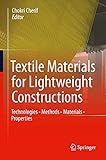Textile Materials for Lightweight Constructions [electronic resource] : Technologies - Methods - Materials - Properties / edited by Chokri Cherif.
Contributor(s): Cherif, Chokri [editor.] | SpringerLink (Online service)
| SpringerLink (Online service) .
.
Material type:  BookPublisher: Berlin, Heidelberg : Springer Berlin Heidelberg : Imprint: Springer, 2016Edition: 1st ed. 2016.Description: XX, 677 p. 457 illus., 63 illus. in color. online resource.Content type: text Media type: computer Carrier type: online resourceISBN: 9783662463413.Subject(s): Materials
BookPublisher: Berlin, Heidelberg : Springer Berlin Heidelberg : Imprint: Springer, 2016Edition: 1st ed. 2016.Description: XX, 677 p. 457 illus., 63 illus. in color. online resource.Content type: text Media type: computer Carrier type: online resourceISBN: 9783662463413.Subject(s): MaterialsPreface -- Acknowledgment -- Introduction -- The Textile Process -- Chain and Classification of Textile Semi-finished Products -- Textile Fiber Materials -- Yarn Constructions and Yarn Formation Techniques -- Woven Semi-Finished Products and Weaving Techniques -- Semi-Finished Weft Knitted Fabrics and Weft Knitting Techniques -- Warp-knitted Semi-finished Products and Warp-Knitting Technologies -- Braided Semi-Finished Products and Braiding Techniques -- Nonwoven Semi-finished products and Nonwoven Production Technology -- Embroidered Semi-finished Products and Embroidery Techniques -- Pre-impregnated Textile Semi-Finished Products (Prepregs) -- Ready-made Technologies for Fiber-reinforced Plastic Composites -- Textile Finishing and Finishing Technologies -- Textile Testing Methods, Modeling and Simulation -- Processing Aspects and Sample Applications.
In this book, experts on textile technologies convey both general and specific information on various aspects of textile engineering, ready-made technologies, and textile chemistry. They describe the entire process chain from fiber materials to various yarn constructions, 2D and 3D textile constructions, preforms, and interface layer design. In addition, the authors introduce testing methods, shaping and simulation techniques for the characterization of and structural mechanics calculations on anisotropic, pliable high-performance textiles, including specific examples from the fields of fiber plastic composites, textile concrete, and textile membranes. Readers will also be familiarized with the potential offered by increasingly popular textile structures, for instance in the fields of composite technology, construction technology, security technology, and membrane technology. Textile materials and semi-finished products have widely varied potential characteristics, and are commonly used as essential elements of innovative, resource-efficient, lightweight and high-tech applications.


There are no comments for this item.